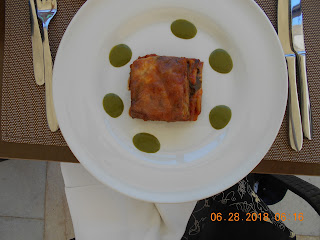What brought me to visit the Baglio Sorìa
terroir of the wine producer Firriato is their carbon neutral policy, from the
vineyard to the bottle. In fact, for all
4.5 million bottles per year, Firriato has minimized carbon emissions in
production and has effectuated global reforestation projects to offset far more
than the emissions that remain in their winemaking processes. Firriato also adheres to a ten-year plan for
renewable energy, practices organic viticulture, and has its water use evaluated
regularly. The list of Firriato’s
sustainability certifications and awards is long, capped most recently by a
2021 Award for Sustainable Viticulture by the platform Gambero Rosso, which
includes a professional development academy in the sector of Italian wine,
food, and hospitality. Firriato also
earned 2021 Certification by Equalitas, an organization dedicated exclusively
to Italian wine sustainability. Firriato’s
goal is transparent verifiability that the bottle we buy at Eataly in New York City
reflects actualized respect for the Sicilian ecosphere based on cutting-edge environmental
science throughout the production of the wine.
Integral to the company’s concept of economic growth is eco-sustainability in its
production, which serves to develop a counter-narrative to petrol-normative
fossil-fuel emissions.
A “baglio” is a traditional fortified group
of structures around a central courtyard, whose plan includes a place for the aristocratic
landowner and housing for the agrarian workers, as well as storage for the
harvest, stables for the animals, workshops, and, in some cases, a guard tower
for security, and a chapel. At night,
the structures were locked down against brigandage. Firriato’s Baglio Sorìa resort inhabits an opulently
restored cluster of structures that date to the 17th century. Stretching out surrounding the Baglio are supernaturally
infinite rows of grape vines and olive trees.
Baglio Sorìa is one of the three diverse, otherworldly landscapes of
Firriato, including the Cavanera Etnea resort and terroir on the slopes of
Etna, and the Calamoni di Favignana villa and estate, by the Trapani seaside.
Firriato was founded by Salvatore and Vinzia Novara di Gaetano, and is now also led by their daughter Irene and her husband, Federico Lombardo di Monte Iato. They have a young daughter called Elide, a name derived from the Greek “Helios,” god of the sun. In online articles ranging from penniless blogs to high-end travel and cuisine magazines, a casual Google search turns up copious accounts of the generous and charismatic hospitality of Federico, my guide to Baglio Sorìa. His commitment to Sicily is encyclopedic. He invokes the mythological sources supporting a Sicilian origin for Dionysus, the Roman Bacchus, the god of wine, and he cites evidence that wine has been in Sicily for over 6,000 years. He waxes poetic on architectural uses of porous bio-calcarenite limestone autochthonous to the island, and enumerates biodiverse heirloom fruits and vegetables, including wine grape varietals. He calls Sicily a treasure chest of biodiversity.
Of the Firriato wines I
tasted, my favorite is Jasmin, made of Sicilian white Zibbibo grapes, fruity
with the jasmine’s suggestion of mystery.
Zibbibo grapes are said to originate in ancient Alexandria—the name
derives from the Arabic, zabib, for
raisin—but their cultivation is integrally identified with Sicily. With the wine, Firriato also generously
treated me to a lunch whose sumptuousness and creativity befitted the mythological
birthplace of Dionysus.
As he drove me back to the train, Federico stopped in the nature reserve encompassing the flats where salt has been mined in Trapani at least
since the twelfth century. The nature reserve today is under the jurisdiction of the World Wildlife Fund. Federico spoke of his friendship with the
people who run the nature reserve and said he drove by from time to time to
provide an extra pair of eyes. Also watching
over the watery salt beds is the eighteenth-century windmill that is a symbol
of the city. In the 21st century, the
windmill’s carbon zero energy serves as a sign of the earth’s only way forward
if we want to stop incineration due to fossil-fuel-driven climate change.





